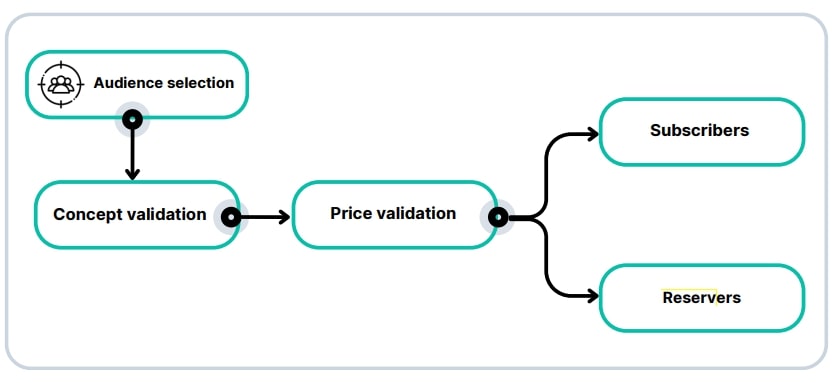Launching a product without proper validation is like jumping out of a plane without a parachute. Are you ready to skydive into success? Let’s dive into the world of product validation and discover how it can be your safety net in the unpredictable market landscape.
What is Product Validation?
Product validation is the process of testing your product concept, design, and features with potential customers before full-scale development or launch. It’s about gathering concrete evidence that there’s a market for your product and that it effectively solves a real problem for your target audience.
Why is Product Validation Important?
Reduces Risk
Validating your product before investing heavily in development can significantly reduce financial and operational risks. By confirming market demand and product-market fit early on, you minimize the chances of launching a product that fails to resonate with your target audience.
Saves Time and Money
Identifying and addressing potential issues during the validation phase is far more cost-effective than making changes post-launch. This proactive approach can save you substantial time and resources in the long run, allowing for more efficient allocation of your budget.
Improves Product-Market Fit
Through validation, you gain invaluable insights into your customers’ needs, preferences, and pain points. This information allows you to refine your product to better align with market demands, increasing the likelihood of success upon launch.
Increases Investor Confidence
Solid validation data can be a powerful tool when seeking funding. Investors are more likely to back projects that have demonstrated market potential and consumer interest, as it reduces their perceived risk.
Enhances Customer Satisfaction
By involving potential customers in the validation process, you’re more likely to develop a product that truly meets their needs. This user-centric approach often leads to higher customer satisfaction and loyalty post-launch.
Key Steps in the Product Validation Process
1. Identify Your Target Market
Begin by clearly defining your ideal customer profile. Conduct market research to understand demographics, psychographics, and behavioral characteristics of your potential users. This foundation will guide your validation efforts and ensure you’re gathering feedback from the right audience.
2. Develop a Hypothesis
Formulate a clear hypothesis about the problem your product solves and how it does so. This hypothesis should be specific, measurable, and testable. For example, “Our product will reduce task completion time by 30% for marketing professionals managing social media campaigns.”
3. Create a Minimum Viable Product (MVP)
Develop a basic version of your product that includes core features. The MVP should be functional enough to demonstrate your product’s value proposition without requiring full-scale development. This could be a prototype, a landing page, or even a detailed mockup, depending on your product type.
4. Gather Feedback
Utilize various methods to collect data from your target audience. This may include surveys, interviews, usability testing, and beta trials. Aim for a mix of quantitative and qualitative feedback to get a comprehensive understanding of user reactions and needs.
5. Analyze Results
Carefully interpret the data you’ve gathered. Look for patterns, common pain points, and areas of enthusiasm. Pay attention to both positive and negative feedback, as both can provide valuable insights for improvement.
6. Iterate and Improve
Based on your analysis, refine your product concept or MVP. This might involve adjusting features, tweaking your value proposition, or even pivoting your entire approach if the data suggests a significant misalignment with market needs.
Product Validation Methods
Effective product validation relies on a combination of different methods to gather comprehensive insights. Here are some key approaches to consider:
Surveys and Questionnaires
Surveys are a quick and cost-effective way to gather quantitative data about your product idea. They allow you to reach a large audience and collect structured feedback on specific aspects of your product.
Pro Tip: Use open-ended questions to gain deeper customer insights. For example, “What challenges do you face when [problem your product solves]?” This can uncover unexpected pain points and opportunities.
Customer Interviews
One-on-one interviews with potential customers provide in-depth qualitative insights. They allow you to explore user needs, preferences, and pain points in detail, often revealing nuances that surveys might miss.
A/B Testing
A/B testing involves comparing two versions of a product feature, design element, or marketing message to see which performs better. This method is particularly useful for optimizing specific aspects of your product or its presentation.
Landing Page Testing
Create a landing page for your product idea and drive traffic to it through ads or social media. Analyze visitor behavior, sign-up rates, and other metrics to gauge interest in your concept.
Prototype Testing
Develop a basic version of your product and let potential users interact with it. This can be anything from a paper mockup to a functional digital prototype, depending on your product type and stage of development.
Pre-orders and Reservation Systems
Pre-orders are a powerful validation tool, proving that customers are willing to pay for your product. However, traditional pre-order systems can sometimes fall short in providing comprehensive insights.

Prelaunch offers an innovative approach to product validation that goes beyond simple pre-orders. Their unique reservation system not only validates interest but also provides deep insights into real purchase intent and helps build a community around your product.
Key features of Prelaunch’s validation mechanism include:
- Audience Selection: Targeted ads and organic traffic from early adopters help identify responsive audience segments.
- Concept and Price Validation: Visitors can subscribe to learn more and place small deposits to reserve products at discounted prices, demonstrating real purchase intent.
- Segmented Surveys: Personalized surveys gather deeper insights based on user actions.
- Market Analysis: Expert research teams provide additional market and competitor insights.
- Multiple Iteration Testing: Brands can test various product features and price points across different audiences.
One significant advantage of Prelaunch’s system is its ability to combat survey fraud. Traditional surveys are often susceptible to AI bots and fraudulent responses, which can skew results and lead to misguided product decisions. By requiring users to make a small financial commitment, Prelaunch ensures that the feedback and data collected come from genuinely interested potential customers. This approach significantly reduces the risk of survey fraud, providing more reliable and actionable insights.
For more information on how AI bots can compromise survey results and how Prelaunch addresses this issue, check out this blog post: AI Bots in Surveys.
This comprehensive approach allows you to engage with early adopters, gather nuanced feedback, and create buzz before your official launch, all while ensuring the validity of your data.
Crowdfunding Campaigns
Platforms like Kickstarter or Indiegogo can serve as both validation tools and funding sources. A successful campaign demonstrates market demand and can provide valuable feedback from early backers.
Social Media Engagement
Use social media platforms to share your product concept and gauge audience reaction. Monitor likes, shares, comments, and direct messages to understand how your target market perceives your idea.
Focus Groups
Gather a small group of potential customers to discuss your product in depth. This method can provide rich qualitative data and unexpected insights through group interaction and discussion.
By combining these methods, you can create a comprehensive validation strategy that provides both broad market insights and deep user understanding. Remember, the key is to choose the methods that best suit your specific product, target market, and stage of development.
Expert Tips for Effective Product Validation
Embrace Customer Insights
Understanding your customers’ needs, preferences, and behaviors is crucial for successful product validation. Use tools like customer journey mapping to gain a holistic view of their experience. Regularly engage with your target audience through focus groups, interviews, and social media interactions to stay attuned to their evolving needs and expectations.
Leverage A/B Price Testing
Don’t rely on guesswork for your pricing strategy. Implement A/B testing to determine the optimal price point that maximizes both conversions and revenue. Test different price points with different segments of your audience to understand price sensitivity and perceived value. This data-driven approach can help you find the sweet spot that balances profitability with market acceptance.
Pro Tip: Maximize your pricing strategy with Prelaunch’s price testing. Test multiple price points across different audience segments simultaneously and gain real purchase intent data through reservations. Unlike traditional surveys, this method provides more accurate, data-driven insights helping you make more informed pricing decisions.
Utilize Concept Validation Landing Pages
Create a landing page that showcases your product concept to test different messaging, features, and designs with real users before building the full product. One of the best ways of going about this is to use platforms like Prelaunch that specialize in concept validation the minute you take your landing page live, you automatically begin tracking analytics and get immediate feedback. Use tools like heat maps and click tracking to understand which elements resonate most with visitors. This method allows you to validate your concept quickly and cost-effectively, providing insights that can guide your development process.
Combine Qualitative and Quantitative Data
While numbers are important, don’t neglect the power of qualitative feedback. Customer stories and experiences can provide invaluable insights for product development. Use a mix of data sources, including surveys, user interviews, and usage analytics, to get a comprehensive picture of your product’s potential. This balanced approach helps you understand not just what users do, but why they do it.
Stay Agile
Be prepared to pivot based on validation results. The market is ever-changing, and flexibility is key to success. Establish a feedback loop that allows you to continuously gather and incorporate user insights throughout the development process. This agile approach enables you to adapt quickly to market changes and emerging user needs, increasing your chances of long-term success.
Conclusion
Product validation is not just a step in the product development process—it’s the foundation of a successful launch. By thoroughly validating your product, you minimize risks, optimize resources, and increase your chances of market success. Remember, the goal is not just to create a product but to solve a real problem for your customers. Start validating today, and watch your product soar to new heights!
FAQs
Q: When should I start validating my product?
A: Start validating your product as early as possible, ideally at the concept stage. Early validation allows you to identify potential issues and market fit before investing significant resources in development. This proactive approach can save you time, money, and potential headaches down the line. Remember, validation is an ongoing process that should continue throughout your product’s lifecycle.
Q: How long does the product validation process take?
A: The duration of the product validation process varies depending on the complexity of your product and the depth of validation you’re conducting. It can range from a few weeks for simple products to several months for more complex offerings. The key is to be thorough without getting stuck in analysis paralysis. Set clear milestones and deadlines to keep the process moving forward effectively.
Q: What is the final step in the product development process
A: The final step in the product development process is typically the product launch, but it’s important to note that product development doesn’t truly end there. After the launch, you enter a phase of continuous improvement based on real-world feedback and performance data. This involves monitoring user feedback, analyzing usage metrics, and making iterative improvements to enhance the product’s features, usability, and market fit. Remember, successful products are those that evolve with their users’ needs and market trends.
Q: Can I validate more than one aspect of my product at the same time?
A: Yes, you can validate multiple aspects of your product simultaneously, and in many cases, this approach can be more efficient. However, be careful not to overwhelm your testers or dilute your focus. Prioritize the most critical elements first, and design your validation process to gather meaningful data on each aspect without creating confusion. Consider using different validation methods for different aspects to get the most accurate and useful feedback.




